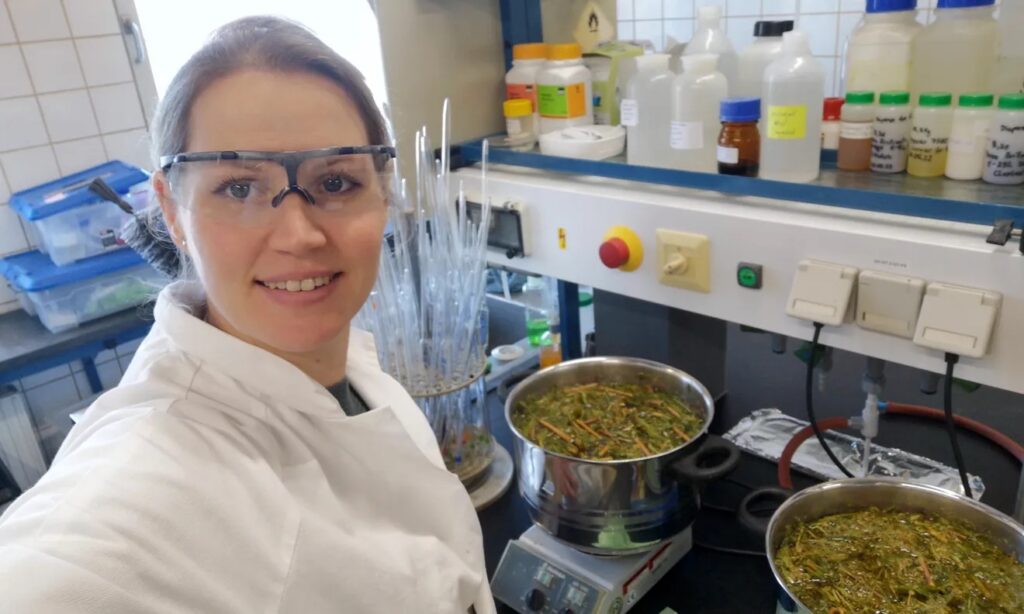
Natural dyes have been used by humans for centuries. Indigo, carmine, purple and ultramarine have been known since ancient times and were only replaced by synthetic dyes during the industrial revolution. The Research Institute for Textile Chemistry and Textile Physics in Dornbirn has been researching natural dyes for over 25 years. Despite a trend towards ecological raw materials, natural dyes have not yet been able to establish themselves in the textile industry. They lose their color intensity more quickly when washed and exposed to sunlight and are more expensive to produce than their synthetic competitors.
However, the industry’s interest in sustainable products is growing strongly. On the one hand, this is due to stricter legislation in the area of sustainability and the circular economy. On the other hand, environmental awareness and the willingness of consumers to spend more money on ecological and sustainable products is growing. Natural dyes and natural pigments are already being used successfully in the food and cosmetics industries. Judith Deriu has been working at the Research Institute of Textile Chemistry and Textile Physics since 2016 and aims to contribute to the development of the circular economy in the textile sector with her research. She is continuing the institute’s tradition and using an ancient process that can be utilized to produce pigments from plants.
“Unfortunately, a lot of knowledge has been lost here,” says the chemist. “In the laboratory, I try to optimize this process to such an extent that industrial partners can test the pigments for different applications in practice.”

The colors of nature
Judith Deriu is primarily looking for red and blue shades, as these have so far been largely absent from the color palette based on natural dyes. “We are still working on this because these pigments are chemically very unstable,” explains the researcher. However, there are already formulations for yellow, ochre, olive green, brown, beige and black that are interesting for industrial use. The pigments are based on waste materials from forestry, agriculture and the food industry as well as other non-food plants. Black can be obtained as wood waste from sawmills, olive green from onion skins, blue from blueberries and blue-green algae and red from grapes and berries. Indigo and madder are deliberately not used as they cannot be produced efficiently in Central Europe. Judith Deriu avoids using plant-based raw materials from distant countries because of the long transportation routes and the associated CO2 emissions.
But it is not only the color pigments that are based on renewable raw materials; binders and fibers required for the production of printing inks are also to be replaced. Judith Deriu is looking for natural alternatives to industrial products made from crude oil.
“Materials made from fossil raw materials have a high impact on nature,” says the chemist. “Microfibers are released from synthetic textiles that cannot be broken down, and artificial binders with pigments are released into the environment as microplastics from the motifs printed on textiles.”
The Dornbirn scientists use their plant pigments to color bio-based cellulose fibers, for example, which are produced from wood using an industrial process. For printing on textiles and paper, Deriu is testing sustainable binders based on biodegradable polysaccharides in order to avoid the creation of microplastics.

Marketable products
Various printing inks are developed in collaboration with industry partners. Paper printing inks for offset printing made from sustainable vegetable oils and resins can be made completely sustainable with the plant pigments.
“However, our pigment particles are still too large for paper printing, they have to be smaller than 3 micrometers,” says the chemist. The results in textile printing, on the other hand, are very promising. “Together with our partners, we are currently looking for products that can be marketed.”
Shopping bags or event T-shirts, for example, are possible candidates. In the paper sector, wrapping paper, packaging materials and paper bags are possible areas of application for the new color piments and printing inks. For clothing, the products still need to be developed significantly so that they can withstand frequent washing.
Cooperation with industry also creates the basis for a network of science, business and all those involved along the value chain. Judith Deriu’s project team includes, for example, textile printers Buntwerk from Vorarlberg, Kelheim Fibres, the world’s leading manufacturer of viscose specialty fibers, Sun Chemical, the most important manufacturer of printing inks, and Verpackungszentrum Graz, the Austrian specialist for ecological packaging.
“To truly establish a circular economy in the textile and printing industry, everyone involved must work together: Science, industry and consumers. My research is a small piece of the puzzle in this joint effort,” says Judith Deriu.
On the researcher

Judith Deriu (*1986) was born in Switzerland and studied biomedicine and Pharmazeutical Toxikology in Amsterdam. In 2016, she joined the Research Institute for Textile Chemistry and Textile Physics at the University of Innsbruck for a doctorate and has been conducting research here as a postdoc since completing her doctorate. She is head of an FFG project on Plant Pigments as sustainable and biodegradable Colorants for coloring Textiles and Paper (PiColor)..
This article appeared in issue 02/23 of the research magazine zukunft forschung of the University of Innsbruck.
Source
University of Innsbruck, press release, 2023-12-28.
Supplier
Agrana
BUNTWERK - textildruck GmbH
Kelheim Fibres GmbH
Offsetdruckerei Schwarzach Gesellschaft mbH
RUEFF Textil GmbH
Sun Chemical
Universität Innsbruck
Verpackungszentrum Graz
Share
Renewable Carbon News – Daily Newsletter
Subscribe to our daily email newsletter – the world's leading newsletter on renewable materials and chemicals












